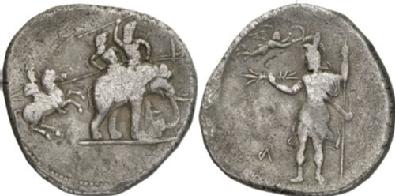The 'Porus Medallion', a silver decadrachm with an image of Alexander the Great
(Coin of the Month, December 2012)
In 326 BC Alexander the Great and his army reached India  where they encountered the army of the Hindu king Porus. At the River Hydaspes Alexander managed to defeat his opponent in a closely fought battle across the monsoon-swollen river. Despite this victory Alexander’s army would advance little further into India. Daunted by the skill and number of the native people and terrified by their elephants, the Macedonians mutinied and demanded to return westwards, to which Alexander eventually agreed. After many trials and tribulations the Macedonian army ultimately returned to Babylon where Alexander would live out the last few months of his life before dying suddenly and mysteriously on the 10th June 323 BC.
where they encountered the army of the Hindu king Porus. At the River Hydaspes Alexander managed to defeat his opponent in a closely fought battle across the monsoon-swollen river. Despite this victory Alexander’s army would advance little further into India. Daunted by the skill and number of the native people and terrified by their elephants, the Macedonians mutinied and demanded to return westwards, to which Alexander eventually agreed. After many trials and tribulations the Macedonian army ultimately returned to Babylon where Alexander would live out the last few months of his life before dying suddenly and mysteriously on the 10th June 323 BC.
The “Porus Medallions” or “Franks Medallion” (named after the donor of the first example of the coin to the British Museum) was discovered in modern Afghanistan in the late 19th century. The obverse shows a cavalryman, identified as a Macedonian by his Phrygian-style helmet and characteristic long lance (or sarissa), charging at an elephant with two warriors mounted on its back. The reverse shows another Macedonian horseman, or possibly the same one, this time standing and being crowned by a winged Victory but still wearing his distinctive helmet. However this Macedonian is carrying what could either be a sarissa or a royal sceptre in his left hand, and more importantly in his right hand he holds the thunderbolt of Zeus. The coin is obviously a reference to the Macedonian victory at the Hydaspes and it is just as clear that the Macedonian figure is intended to be Alexander himself, both through his wielding of the thunderbolt of his ancestor Zeus and through the distinctive white plumage which Plutarch tells us the king wore on either side of his helmet. The standing figure mounted on the elephant and brandishing a spear on the obverse has been identified as Porus because of the figure’s height. Porus is described in almost all primary sources as extremely tall, sometimes as over 2.1 metres or 7 feet tall, and the height of the figure on the elephant would certainly tally with those measurements. On some examples of the medallion it is even possible to discern the foot of the rider behind the elephant about halfway up its leg, adding further emphasis to the prodigious height of the man.
The depictions of Alexander and Porus on the medallions are interesting, but it is the dating of the coin that makes it truly fascinating. It is almost impossible to tell exactly when the coin was minted due to the lack of any kind of legend. However the coin has been approximately dated to the very end of Alexander’s lifetime, minted in Babylon either shortly before or shortly after his death in 323 BC. If we take the date before Alexander’s death and accept that it is Alexander himself featured on the reverse, then this series of coins is remarkable. It would represent not only the sole surviving depiction of Alexander the Great produced in his lifetime, but would be the earliest known image of an identified living person on coins. This coinage provides not only an intriguing mystery for numismatists but could also provide remarkable insight into the mindset of Alexander and his views on his own divinity. They also demonstrate, through the use of an image of a living person as a type, the development of coin types as a form of propaganda which would continue to be used throughout history.
![]() This month’s coin was chosen by Nathan Murphy, a final year Ancient History and Classical Archaeology undergraduate. Nathan’s research interests include the social and economic function of coinage and the spread of money in the ancient world. His dissertation is focussing on the monetisation of the Roman countryside between the first and fourth centuries AD, looking at the levels of monetary use among rural populations in Roman Egypt, Syria and Britain.
This month’s coin was chosen by Nathan Murphy, a final year Ancient History and Classical Archaeology undergraduate. Nathan’s research interests include the social and economic function of coinage and the spread of money in the ancient world. His dissertation is focussing on the monetisation of the Roman countryside between the first and fourth centuries AD, looking at the levels of monetary use among rural populations in Roman Egypt, Syria and Britain.
(Coin image above reproduced courtesy of Baldwin's Auctions Ltd, New York Sale XXVII, 304).
 Clare Rowan
Clare Rowan


 Loading…
Loading…
Add a comment
You are not allowed to comment on this entry as it has restricted commenting permissions.